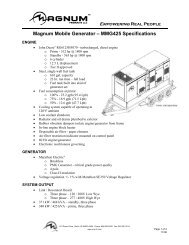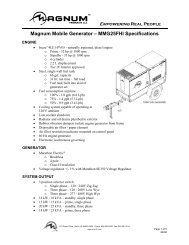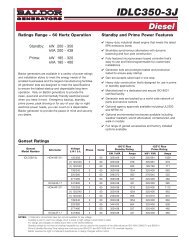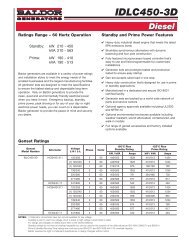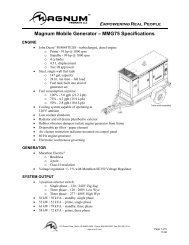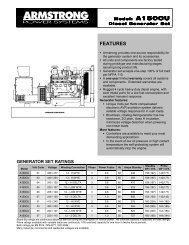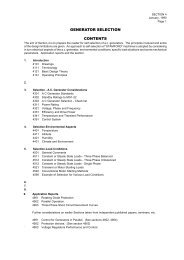GENERATOR SELECTION CONTENTS - Diesel Generator
GENERATOR SELECTION CONTENTS - Diesel Generator
GENERATOR SELECTION CONTENTS - Diesel Generator
You also want an ePaper? Increase the reach of your titles
YUMPU automatically turns print PDFs into web optimized ePapers that Google loves.
Voltage.<br />
The relationships of the machine governing voltage level are more complex.<br />
SECTION 4121<br />
January, 1990<br />
Page 3<br />
Output Voltage (V) depends on 1) Driven Speed (rev/min)<br />
2) Number of turns of copper wire in output winding.<br />
3) Strength of magnetic field produced by the main field excitation<br />
magnetic poles.<br />
The number of turns of copper wire in the output winding is fixed by the machine manufacturer. Voltage is also<br />
affected by driven speed. In fact with a constant magnetic field strength, voltage as well as frequency would be<br />
directly proportional to driven speed.<br />
As the speed is fixed to obtain the correct frequency, the only variable left can be used to change and fix the machine<br />
voltage level is the magnetic field strength. This is exactly the parameter that the machine’s control system does<br />
adjust in order to set the voltage level, and compensate for both speed and load current changes. Let us now take a<br />
look at the control systems that are readily available.<br />
Control System.<br />
These are two popular methods of voltage control system for a.c. generators, firstly a closed loop electronic system<br />
and secondly, an open loop transformer system.<br />
a) Electronic System.<br />
This system continually monitors the output voltage an compares it with a reference voltage level set by the user.<br />
Once the reference voltage level is set, the automatic voltage regulator (AVR) will automatically compare the actual<br />
output voltage with the reference voltage level and if they are different will adjust the magnetic field strength to make<br />
the output voltage the same as the reference voltage. This system is therefore an accurate closed loop control by<br />
using static magnetic amplifiers (combinations of transformers of transformers and controlled reactors). This system<br />
is very reliable although slow in operation and very bulky compared to the electronic systems which have now virtually<br />
superseded it.<br />
b) Transformer Control.<br />
This system is really in two parts, firstly adjustment for no load voltage level and, secondly, compensation for load<br />
current. This system once set up is not normally adjusted. It is an open loop control system; there is no continuous<br />
monitoring to adjust the output voltage. It can only provide the amount of magnetic field strength it has been set up to<br />
provide.<br />
Machine Types<br />
Previously we have stated that rotational speed must be maintained between the output winding (the ‘wire’) and the<br />
field winding, (the ‘magnet’). Also we have assumed that the field winding is rotated with the output winding remaining<br />
stationary. This type of machine is logically called a rotating field a.c. generator and an example of such a machine is<br />
the Newage Stamford Brushless range. In fact all brushless machines are rotating field types, but as we see in figure<br />
2, not all rotating field type machines are brushless.<br />
The alternative is to rotate the output winding whilst keeping the field winding stationary. This still complies with all the<br />
basic requirements for voltage generation and such a machine is called a rotating armature a.c. generator. An<br />
example of such a machine was the Newage Stamford ‘D’ range.<br />
Operation.<br />
In the next part the combined operation of the machine with the control system will be examined in more detail.



